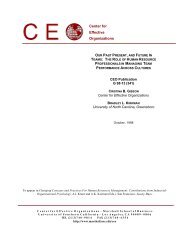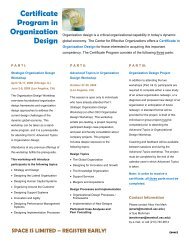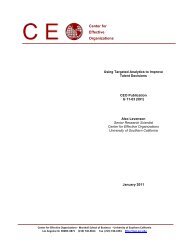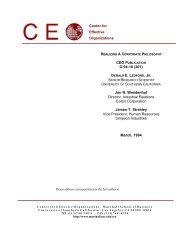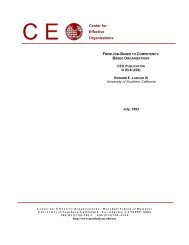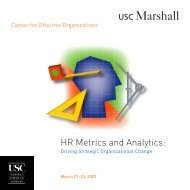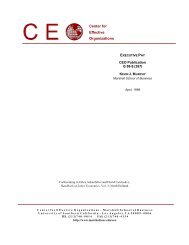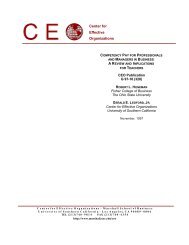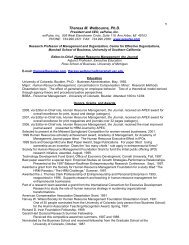Global Talent 2021 - Oxford Economics
Global Talent 2021 - Oxford Economics
Global Talent 2021 - Oxford Economics
- No tags were found...
You also want an ePaper? Increase the reach of your titles
YUMPU automatically turns print PDFs into web optimized ePapers that Google loves.
<strong>Global</strong> <strong>Talent</strong> <strong>2021</strong>How the new geography of talent will transform human resource strategiesMarket transformation is redefining thesupply and demand for talentEverywhere across the globe, wrenching business changes are touching everyfirm and industry. Profound shifts in the global marketplace are ushering in a newera of complexity, uncertainty and change for companies. The rise of the internetand related technology has accelerated these market shifts, up-ending businessstrategies, models and processes along the way.“Our transformation hasreally shifted the way wethink about our businessstrategically.”Libby Wanamaker, <strong>Global</strong>Director, ProgramDevelopment for Coca-ColaSurvey participants identify advances in technology (42%) and globalization (41%) aswell as shifts in labor demographics (38%), customer needs (38%) and competition(38%) as underlying forces that will have the biggest impact on their organization’stalent requirements in the years ahead. Even for firms that have operated across theglobe for decades, the issues are substantial and ever more complex. “Ultimatelyour company has come to terms with the fact that we are truly a global entity thatneeds to operate at both the global and local level,” explains Libby Wanamaker,<strong>Global</strong> Director, Program Development, Coca-Cola. “Our transformation has reallyshifted the way we think about our business strategically.”Business transformation requires new skillsAs a result of these rapid shifts in the market, the vast majority of companies areengaging in transformation initiatives to rethink their global strategies, business modelsand organizational approaches. Indeed, according to our survey, 41% have recentlycompleted a significant transformation initiative or are currently undergoing one. Andanother 47% of those surveyed are preparing to do so. For certain industries, such asfinancial services and heavy manufacturing, the total of those that have or plan to gothrough business transformation is even higher (more than nine out of 10).Figure 2: Transformation is pervasive across industriesPlease select the statement that best applies to your firm’s business transformation efforts.Recently completed Currently undergoing Preparing to undergo Not recentlyTotalFinancialservicesHeavymanufacturingTravel andtransportationTICE>$5bn
<strong>Global</strong> <strong>Talent</strong> <strong>2021</strong>How the new geography of talent will transform human resource strategiesThis transformation also requires a repositioning of employee skill sets, across alllevels of employment. Our study identified four broad areas where skills will be ingreatest demand. These include:1. Digital skills. The fast-growing digital economy is increasing the demand for highlyskilled technical workers. In particular, the emergence of social media is puttinga premium on developing new forms of digital expression and marketing literacy.According to our survey, of all technical capabilities, digital business skills are seenas most critical—particularly in Asia-Pacific, where e-commerce is mushroomingbecause of the early adoption of new digital technology as way to “leapfrog” aninefficient legacy infrastructure. In Europe, where economic conditions are weaker,the use of business software and systems to build internal efficiencies will continueto be a high priority.2. Agile thinking. In a period of sustained uncertainty, where economic, politicaland market conditions can change suddenly, agile thinking and the ability toprepare for multiple scenarios is vital. In industries that face significant regulatoryand environmental cross-currents, such as life sciences, and energy and mining,the ability to prepare for multiple scenarios is especially important—72% and 71%respectively, compared with 55% for the overall pool of respondents. To succeed inthe changing marketplace of the future, HR executives also put a high premium oninnovative thinking, dealing with complexity and managing paradoxes.Figure 3: Skills in high demand over the next five to 10 yearsDigital skillsDigital businessskillsAbility to workvirtuallyUnderstandingof corporate ITsoftware andsystemsDigital designskillsAbility to usesocial media and“Web 2.0”50.6% 44.9% 40.1% 35.2% 29.3%Agile thinking skillsAbility toManagingconsiderDealing withparadoxes, Ability to see theand prepare Innovation complexity andbalancing “big picture”for multipleambiguityopposing viewsscenarios54.8% 46.0% 42.9% 40.9% 15.3%Interpersonal and communication skillsCo-creativity andbrainstormingRelationshipbuilding (withcustomers)Teaming(including virtualteaming)CollaborationOral and writtencommunication48.3% 47.4% 44.9% 30.4% 29.0%<strong>Global</strong> operating skillsAbility tomanage diverseemployeesUnderstandinginternationalmarketsAbility to workin multipleoverseaslocationsForeignlanguage skillsCulturalsensitivity49.1% 45.7% 37.5% 36.1% 31.5%Source: <strong>Oxford</strong> <strong>Economics</strong>5OXFORD ECONOMICS
<strong>Global</strong> <strong>Talent</strong> <strong>2021</strong>How the new geography of talent will transform human resource strategies3. Interpersonal and communication skills. Overall, HR executives believe thatco-creativity and brainstorming skills will be greatly in demand, as will relationshipbuilding and teaming skills. This reflects the continued corporate shift from acommand-and-control organization to a more fluid and collaborative style. Asenterprises of the future respond to the development of a “networked” corporateworld, where relationships with suppliers, outsourcing partners and even customersbecome more dispersed and nuanced, the capacity to align strategic goals, buildconsensus and encourage collaboration will become paramount. The challenge ismade all the greater because of the vast variety of geographies and cultures that willbe encompassed by tomorrow’s extended global enterprise.The most dramatic jumpin demand, according tosurvey respondents, willbe in emerging Asia,where the need for newemployees will rise 22%.4. <strong>Global</strong> operating skills. Reflecting the impetus of firms to expand in marketsaround the world, the facility to manage diverse employees is seen as the mostimportant global operating skill over the next five to 10 years. In the US, wherecompanies are embracing globalization and seeking to penetrate new markets,understanding international business was identified as the top global operating skillrequired. These operating skills will become even more important as globalizationenters its next phase. Indeed, according to Jeff Immelt, Chairman and CEO of GE,firms will increasingly move from “glocalization,” where home market products andservices are tailored to the tastes of overseas customers, to reverse innovation,under which innovation is led from emerging markets and then brought back hometo mature markets. Such global operating trends, which are already evidenced inboth life sciences and engineering firms, will require a global redistribution of keyskill sets.Permanent shifts in the business demand for talentAs firms contend with the transformation of their businesses, and the “reskilling”of their workforces, they must also prepare for long-term, permanent structuralshifts in demand for labor. Indeed, a new geography of talent will come to defineworkplace recruitment.The demand for workers is already more pronounced in emerging markets thanksto continued brisk growth in most of these economies. The most dramatic jumpin demand, according to survey respondents, will be in emerging Asia, where theneed for new employees will rise 22%. Other emerging markets that will see aboveaverage growth in demand are Latin America (13%), Middle East/Africa (13%) andEastern Europe (10%).Demand for talent in Western Europe, by contrast, is projected to grow a rathermodest 3.5%, according to our survey. In some industries like business services,energy, travel and transport, and life sciences, staffing demand will actually declineas Europe copes with its ongoing debt crisis and austerity-driven recession.Somewhat stronger job demand is expected in North America, where surveyedexecutives expect overall employment requirements to rise 6.1% over the next fiveto 10 years as a result of more resilient economic conditions.6OXFORD ECONOMICS
<strong>Global</strong> <strong>Talent</strong> <strong>2021</strong>How the new geography of talent will transform human resource strategiesFigure 4: The future demand for talentHow will the landscape for talent change over the next five to 10 years?Total (%change)WesternEuropeNorthAmericaDevelopedAsiaEasternEuropeMENALatinAmericaEmergingAsia3.5% 6.1% 10.0% 10.0% 12.7% 13.0% 22.2%Industrial -0.5% -2.4% 11.4% 2.4% 28.7% 17.1% 37.7%Emerging 26.1% 38.3% 8.4% 19.8% 6.3% 10.2% 13.3%Heavymanufact.BusinessservicesFinancialservices24.6% 1.7% 1.7% 33.2% 10.3% 17.8% 60.3%-4.4% 0.3% 51.4% 6.8% 30.1% -0.6% 40.0%13.2% -8.1% 4.9% -9.9% 31.6% 48.6% 20.9%Energy -11.3% 22.7% 8.0% 8.7% 12.2% -11.9% 33.0%Travel andtransport-9.3% -1.4% 36.5% 5.0% 14.1% 32.9% 32.6%Life sciences -4.1% 4.2% 8.2% 19.7% 8.6% 20.4% 16.6%Source: <strong>Oxford</strong> <strong>Economics</strong>The outsourcing of manufacturing jobs from the developed to the emerging worldand the long-term effects of the financial crisis of 2008 means employment incertain industries is likely to shrink permanently in mature economies. In the USalone, Bureau of Labor Statistics data clearly illustrates that the sharp declinein construction and manufacturing that resulted from the financial crisis was notfollowed by a rapid “snap back” after the crisis passed, as was typical of previousrecessions. In part, this reflects the rising competitiveness of emerging markets inlow skilled manufacturing. Similarly, demand for industrial workers in emerging Asiais expected to rise 37.7% and in Latin America by 17.1%, while in North Americademand is forecast to decline by 2.4%.Figure 5: US employment by sectorChange in employment by sector (in 000s)10005000-500ConstructionGovernmentManufacturingFinancial servicesOtherProfessional andbusiness servicesRetail-1000-1500-2000-2500Jan ’08Jul ’08Jan ’09Jul ’09Jan ’10Jul ’10Jan ’11Jun ’11Jan ’12Source: Bureau of Labor Statistics7OXFORD ECONOMICS
<strong>Global</strong> <strong>Talent</strong> <strong>2021</strong>How the new geography of talent will transform human resource strategiesThe talent pool moves from industrial to emerging marketsIn the last decade, rapidly growing nations like India and China siphoned off manylow-wage and relatively unskilled manufacturing jobs from the developed world,causing dramatic dislocations. In the coming decade, these nations will move upthe skills ladder as they improve access to high-quality education. A demographicbulge, accelerating economic growth and technology-enabled training will alsocontribute to the dramatic rise in the number of college-trained talent developingmarkets are expected to produce. Of the major emerging markets, the fastestannual talent pool growth will be in India (7.3%), followed by Brazil (5.6%), Indonesia(4.9%), Turkey (4.7%) and China (4.6%).Over the next decade, thepercentage of collegeeducatedtalent will riseto 60% in the E7—some217 million workers, asopposed to 143 million inthe developed world.But for many developed countries, particularly in Europe, the next decade will seea further slowdown in population growth and continued aging of the workforce.Paradoxically, the biggest losers may be economies that have made the greateststrides in tapping potential talent by increasing access to education and raisinglabor market participation, since they will have less scope to boost talent supply.At 1.4% and 1.3% a year, respectively, the US and Canada will lead the G7 inannual talent growth, while France (0.9%), UK (0.7%), Italy (0.5%), Japan (0.4%) andGermany (0%) will lag.The impact of the global distribution of talent will be dramatic. Already, over half ofthe world’s college graduates (54%) come from the top emerging markets (the E7:Brazil, China, India, Indonesia, Mexico, Russia and Turkey), compared with 46%from the industrialized world (the G7: Canada, France, Germany, Italy, Japan, UKand US). Over the next decade, the percentage of college graduates will rise to 60%in the E7—some 217 million workers, as opposed to 143 million in the developedworld. Perhaps most tellingly, China will overtake the US as the country with thelargest single pool of educated talent.Figure 6. Growth in the college-educated talent poolTertiary educated (“talent”): E7 and G7 countriesIndiaBrazilIndonesiaTurkeyChinaMexicoUSACanadaFranceUKItalyJapanRussiaGermany-1% 0% 1% 2% 3% 4% 5% 6% 7% 8%% growth 2010–<strong>2021</strong>Source: <strong>Oxford</strong> <strong>Economics</strong>8OXFORD ECONOMICS
<strong>Global</strong> <strong>Talent</strong> <strong>2021</strong>How the new geography of talent will transform human resource strategiesFigure 7. Size of college-educated talent poolTertiary educated (“talent”): E7 and G7 countries—<strong>2021</strong>Brazil3%Japan7%Mexico3%Other10%China28%Russia11%India13%US25%Note: “Other” contains those withless than 2% of the total, includingCanada, France, Germany,Indonesia, Italy, Turkey and the UK.Source: <strong>Oxford</strong> <strong>Economics</strong>Will supply meet demand?Developing nations understand that as technology changes rapidly and diffusesreadily, sustained investments in education and training can pay off by helping youngworkers in their countries become critical players in future waves of innovation.There is no ironclad rule mandating that areas like the Silicon Valley in the USwill be the only home of future innovation and job creation, as nations like Chinaand India invest in industries ranging from life sciences to renewable energy andspace exploration. In fact, eight of the top 10 countries likely to boast the largesttalent surpluses a decade from now will be in the developing world, led by India,Indonesia, Colombia and South Africa. Even though these countries are expectedto experience robust economic growth, more skilled workers will be produced thanjob opportunities will appear.With the digital divide now operating in reverse, the South, rather than the North,could become the major source of technical talent a decade from now. Moreover,as the flow of capital and technology becomes increasingly frictionless across theworld, centers of innovation and product development are likely to spring up inpreviously unheralded regions.Cummins Inc. has experienced this shift firsthand. An engine manufacturer withoperations in 52 countries, Cummins now generates over 60% of its revenue fromits foreign operations, yet until recently ran its lone engineering center from itsheadquarters, in Columbus, Indiana. As new plants open in fast-growing marketslike Brazil and Turkey, HR executives like Paul Wright, the company’s <strong>Global</strong> DiversitySpecial Projects Manager, will need to recruit the right talent to fill those newlycreated jobs, and standardize job categories that exist in different geographies. “HRis at the center of planning now,” says Mr. Wright. “We’re trying to make it easierto identify and move talent around the world as we need it and to help offer peopledevelopment opportunities.”9OXFORD ECONOMICS
<strong>Global</strong> <strong>Talent</strong> <strong>2021</strong>How the new geography of talent will transform human resource strategiesMeanwhile, labor shortages are projected to appear in many mature markets, includingthe US, Germany, Canada and Italy, in part because of their aging populations andbecause much of their population is already relatively well-educated, offering lessroom for meaningful improvement. Faced with recession and budget constraints inthe wake of the 2008 economic crisis, many of these countries will fall further behindin the race between education and technology.Figure 8: The mismatch between supply and demand for talent in <strong>2021</strong>Strongest trendtalent surplusDemand and supply fortalent in balanceStrongest trendtalent deficitIndiaIndonesiaColombiaSouth AfricaBrazilMoroccoCzech Rep.EgyptQatarPeruCosta RicaBahrainUAEPhillippinesSource: <strong>Oxford</strong> <strong>Economics</strong>Saudi ArabiaBarbadosMalaysiaKuwaitOmanBermudaChinaArgentinaMexicoRussiaSpainSwitzerlandAustriaNetherlandsSwedenAustraliaNorwayThailandSingaporeGermanyFrance2.11.51.11.01.00.80.80.70.60.60.50.40.20.20.20.20.10.10.10.10.0-0.1-0.1-0.1-0.4-0.4-0.4-0.4-0.4-0.5-0.5-0.6-0.6-0.6-0.6-0.7-0.8-0.8-0.9-0.9-0.9-1.0-1.1-1.2-1.4-1.5Notes1. The table ranks countries according to how their talent gaps are expected to evolve over the next decade.2. <strong>Talent</strong> deficits are shown as red (negative numbers), talent surpluses as green (positive numbers), andbroad balance as yellow.3. Numbers report the average annual % change of the deficit/surplus.TurkeyCanadaSouth KoreaGreeceUKUSAChileItalyPolandJapanTaiwanA closer examination of two major economies, India and China, help illustrate thedynamic forces at work in this new landscape for talent. On our “heat map” outliningthe projected balance of supply and demand for skilled labor, China is shown inbalance: Its heavy investment in education will enable it to meet its talent needsand sustain its rapid economic development, even as its population growth levelsoff and its population begins to age. Its projected 4.6% annual increase in collegeeducatedtalent will roughly match its economic growth.“In China we don’tencounter a problem interms of ‘supply.’ Theissue for us and manymultinationals is how tofoster their loyalty andengagement longer-term.”Randall Bradford, InternationalVice President for HumanResources, MedtronicFor Medtronic, the world’s largest medical technology company and maker ofpacemakers, defibrillators, stents and other medical devices, China is expected tosomeday become the firm’s largest single market. Randall Bradford, InternationalVice President for Human Resources, says the firm has found the market forqualified workers very rich: “In China we don’t encounter a problem in terms of‘supply.’ There is plenty of well-educated talent there. The issue for us and manymultinationals is how to foster their loyalty and engagement longer-term.”India, by contrast, is projected to top the country rankings in terms of its surplusof educated talent. This surplus results from its young and rapidly growing pool ofworkers and some educational improvements (although much less dramatic thanin neighboring China). While India’s pool of college-educated talent is expectedto rise more than 45 million in 10 years, it will exceed that which can be absorbedby the Indian economy. This will compress the wage premium for talent, allowingfor investment in new technologies and business models that will fuel growth wellbeyond <strong>2021</strong>.10OXFORD ECONOMICS
<strong>Global</strong> <strong>Talent</strong> <strong>2021</strong>How the new geography of talent will transform human resource strategiesFigure 9: Employment growth in IndiaChange in employment by sector since 2008 (in 000s)160001400012000100008000AgricultureConstructionManufacturingTradeOther services6000400020000-200020082009201020112012Japan is already experiencing a decline in overall population, while its demand fortalent will increase modestly. Its supply of educated talent will expand by only 0.4%over the decade. Since Japan’s economy is largely closed to immigration of largenumbers of skilled managers and technicians, the net result is that Japan’s talentdeficit is expected to be second largest in <strong>2021</strong> among the nations studied. Indeed,nine of the 10 countries projected to experience the most pronounced talent deficitswill be industrialized nations.Figure 10: <strong>Global</strong> Heat MapThe gap between the growth in demand and the growth in supply of talent, 2011 to <strong>2021</strong>(Red indicates a trend deficit, green a trend surplus, yellow a broad balance. Numbers show trend growth as annual percentages.)-0.9-0.8-0.10.51.10.1-0.2-0.5-0.8 -0.4 -0.4-0.6 -1.20.8-0.4 -0.6-0.4 -0.4-1.10.70.80.90.70.2 2.1-0.2-0.10.0-0.6-1.4-0.9-1.50.20.61.00.41.5-1.0-0.11.0-0.511OXFORD ECONOMICS
<strong>Global</strong> <strong>Talent</strong> <strong>2021</strong>How the new geography of talent will transform human resource strategiesManaging the talent mismatchThe talent mismatch—between where talent is most needed and where it will be mostavailable—is not likely to evaporate soon. Managing this skills gap in the developedworld and recruiting appropriate talent in the emerging economies will becomea critical task for global firms in the future. In the developed world, where talentshortages in a number of managerial and technical fields are expected to persist,companies will be forced to think more explicitly about the trade-offs betweenoutsourcing work, off-shoring staff and retraining workers. Likewise, decisionsabout where to locate new centers of innovation, product design or advancedengineering may become focused on geographies not previously considered bythe C-suite. Firms will also need to become more proactive about partnering withrelevant government and educational institutions to develop and train workers, asthey come to anticipate more accurately their turnover and retention rates and theirfuture workforce demands.An example of one forward-looking firm is Lenovo, the China-based computermaker. To support its global growth, Lenovo is partnering with top-ranked Chineseuniversities to identify top talent that may have gone abroad to study, but might beinterested in returning to work in the motherland. “We’re looking to build that talentpipeline three or four years down the road,” explains Robert Gama, the firm’s VicePresident of Human Resources. “If we continue to outpace the market and becomethe leading PC+ vendor in the world, we will need to double the number of ourleaders across the company. We are always looking to attract the best talent aroundthe world.”12OXFORD ECONOMICS
<strong>Global</strong> <strong>Talent</strong> <strong>2021</strong>How the new geography of talent will transform human resource strategiesRethinking HR strategies for the newglobal marketplaceA more analytical,evidence-based approachwill not only lead to betterHR results, but willgenerate greater supportfrom senior managementwho require soundbusiness cases formaking decisions.Business transformation and the new geography of talent will call for a fresh HRapproach and mindset. To manage the enormous change process, HR executiveswill need to use new analytical tools to understand and plan for the future, assessthe impact of decisions, optimize performance, prepare for different scenariosand align talent management with larger corporate strategies. A more analytical,evidence-based approach will not only lead to better HR results, but will generategreater support from senior management who require sound business cases formaking decisions.“For the last 15 to 20 years we’ve focused HR leaders on efficient delivery of services,”says Ravin Jesuthasan, <strong>Talent</strong> Management Practice Leader for the consulting firmTowers Watson and co-author, with Dr. John Boudreau of the Center for EffectiveOrganizations at the University of Southern California, of Transformative HR: HowGreat Companies Use Evidence-Based Change for Sustainable Advantage. “Todaythe opportunity is for HR to transform how firms manage talent, enabling businessleaders to make better decisions about human capital.” Integrating these new HRtools can help firms optimize their talent and boost employee performance.Building on the transformative principles outlined in this book, our research revealsfive important steps firms should take to retool HR for the changes ahead.1. Use more sophisticated analytical tools for making global decisions.Over the next three years, companies will increasingly rely on logic-driven analyticsto make better decisions about the supply and demand of talent. According to Dr.Boudreau, “under a logic-driven approach, firms should identify the most pivotalorganizational issues and use robust analytics to describe the issues and assess thelikely outcomes.” Best practice will entail the consistent use of analytics to generateinsights, test alternatives, monitor progress and measure business impact.As firms globalize, they will also need globally integrated HR data systems. Our surveyshows that the use of data from globally integrated HR information systems (HRIS) willrise from 39% to 47%, and from regional or divisional HRIS from 40% to 46%. Whileless than half of our survey respondents say their HRIS are integrated today, 63%say they will make this transition in the next three years. And while only 52% of firmstoday say they possess a “strong understanding” of the HR metrics that matter to eachbusiness unit, 65% of respondents expect this to be true in three years.More rigorous data analysis offers firms many benefits. For ATK, a global defense,aerospace and commercial products company headquartered in the US, analyticaltools are crucial for workforce planning. “Our data analysis allows us to be proactiveand forward-looking in recruiting,” says Carl Willis, Vice President for HumanResources in ATK’s sporting group. Such analysis lets him see “where the businessis going and what kind of talent we’re going to need in the future.”13OXFORD ECONOMICS
<strong>Global</strong> <strong>Talent</strong> <strong>2021</strong>How the new geography of talent will transform human resource strategiesFigure 12: More firms are accepting HR riskMy firm understands that risk can be leveraged for the economic benefit of theorganization in a disciplined way.In three yearsTodayTotalHeavymanufacturingFinancialservicesConsumergoodsFood productsand servicesTechnologyand media0% 20% 40% 60% 80% 100%% of respondents agree/strongly agreeSource: <strong>Oxford</strong> <strong>Economics</strong>Figure 13: Future plans to measure and manage HR riskTotal Industrial Emerging >$5bn
<strong>Global</strong> <strong>Talent</strong> <strong>2021</strong>How the new geography of talent will transform human resource strategiesBoosting engagement through evidence-based changeSince evidence-based analysis was a key focus of our study, it seemed fitting to apply thisprinciple to our own work.As part of this survey, we asked firms 42 targeted questions on the five core principles ofevidence-based change: logic-driven analytics, segmentation, optimization, risk leverage, andintegration/synergy. We also asked them to evaluate how levels of employee engagement—work commitment and enthusiasm—had changed over the past three years. We then usedregression analysis to investigate the correlation between the five principles and engagement.Our research shows conclusively that implementing the five HR principles boosts employeeengagement. Among the firms that use the principles, the ones that emphasize optimization,risk leverage, and integration/synergy have the best engagement performance. This reflectsthe typical development path of evidence-based change, since HR executives normally startwith the fundamentals of logic-driven analytics and then move on to the more advancedprinciples of optimization, risk leverage and integration/synergy. It follows that the firms at thevanguard of these HR principles would experience the best results.5. Align HR strategies with business transformation objectives.Our research shows the increasing importance of integration/synergy as atransformative HR tool. Though difficult to engineer in times of constant change,aligning business and talent management strategies will be crucial for success in thefuture. Equally important, HR executives will need to understand how HR solutionsand organizational processes mesh with each other to deliver a more integratedapproach to talent management.“HR has become more strategic because of the recognition that in the end, talent iswhat is going to make or break us,” Ms. Wanamaker of Coca-Cola says.Our survey shows that as HR managers come to rely more on evidence-based tools,HR functions will become more strategic within companies. Some 49% say HR andbusiness heads already share governance of people programs today; this figure isexpected to rise to 54% in three years. In addition, 57% say that HR initiatives aretoday brought together under key strategic goals; 66% expect this to be the casein three years.17OXFORD ECONOMICS
<strong>Global</strong> <strong>Talent</strong> <strong>2021</strong>How the new geography of talent will transform human resource strategiesFigure 14: HR is becoming more strategicHR and business heads share the governance of people programs.In three yearsTodayTotalHeavymanufacturingBusinessservicesFinancialservicesFood productsand servicesLife sciencesand healthcareSource: <strong>Oxford</strong> <strong>Economics</strong>0% 10% 20% 30% 40% 50% 60% 70%% of respondents18OXFORD ECONOMICS
<strong>Global</strong> <strong>Talent</strong> <strong>2021</strong>How the new geography of talent will transform human resource strategiesCalls to actionOver the next decade, the dramatic shifts in the global marketplace will weigh heavilyon all firms. The ability to attract and retain quality workers will be challenging,particularly as competition increases between new upstarts in fast-growth marketsand long-established firms in the industrialized world. To meet these challenges,companies will need to rely on HR executives who are skilled at working in diversecultures, managing complexity and change, applying the latest analytical tools andthinking creatively about filling future skill gaps before they emerge.Companies will need torely on HR executiveswho are skilled atworking in diversecultures, managingcomplexity and change,applying the latestanalytical tools andthinking creatively aboutfilling future skills gapsbefore they emerge.Executives have a good sense of where the best investments in HR should be made.When asked which HR strategies and tools will deliver the highest payoff, 47% citetraining and career development, 43% say recruitment and retention, and 38% citereward and recognition plans. Firms in energy, heavy manufacturing and consumergoods say technology investment is key, while companies in construction, foodproducts, and travel and transport cite better analytics and reporting tools.To stay ahead of the curve, companies should consider the following:■ Apply the same rigor, effort and sophistication to human capital planningas is given to designing overall business strategy. No change in businessstrategy can be successful without ensuring that human capital plans are wellaligned. The same discipline and tools associated with forecasting needs, suchas scenario planning, will become increasingly valuable to HR professionals.Evidence-based personnel management will become a critical success factor asfirms ponder new business models or entering new markets.■ Think more broadly about how and where talent is sourced. Greater volatilityand emerging talent shortages in key fields will require organizations to rethinkmany traditional employment relationships. HR executives will need to recruitfor talent in new and sometimes unexpected geographies, as talent surplusesdevelop in some fast-growing markets while mature markets face talent deficits.They will also need to revisit traditional employee/employer relations: Questionsof outsourcing or on-shoring specific talents and jobs will become much moresalient in the future.■ Be prepared to invest more in retraining and reskilling. An open dialogueand partnerships with educational institutions and government employmentdevelopment agencies can help firms ensure a healthy talent pipeline, particularlyin fast-growth markets. Developing programs that train and educate workers notonly helps with recruiting but improves employee loyalty.■ Take a greater evidence-based approach to talent management. Employingworkforce analytics to assess and segment talent, and using quantitative tools toidentify risk and integrate HR into business planning can lead to superior results.Making your workforce aware of how analytical tools are being used—and thatperformance is being measured and rewarded—can powerfully reinforce amessage that people are at the center of any successful business transformation.19OXFORD ECONOMICS
<strong>Global</strong> <strong>Talent</strong> <strong>2021</strong>How the new geography of talent will transform human resource strategies■ Improve employee engagement. Employers who are candid with theiremployees about how they rate relative to peers and what future leadershippotential they possess may find their workers more motivated to develop newskills and master new techniques. Such programs are vital for service companiescentered on talent, such as business services and financial firms. Makingemployees feel more part of the conversation is critical to business success, andclosely correlates to the overall health and prosperity of company.The global rebalancing of the demand and supply of talent will have enormousimplications for government. The race among educational institutions andgovernments to keep up with rapidly changing technology will occur in every country.Those nations that win the race will build a talent surplus that will drive economicperformance; those that lose the race may see their competitiveness erode. Toensure that the supply and demand of talent are well aligned, governments will wantto work in partnership with companies in pursuing the following policies:■ Ensure that education policy is fully integrated into larger economic growthstrategies. Expanding access to education, increasing the average numberof years of schooling and improving the quality of education in key curricula(e.g., science, technology, engineering and mathematics), should be areas ofparticular focus. Educational institutions should listen to the needs of businessand government in monitoring talent gaps and anticipating where futureshortages may arise. Firms can also actively assist educational institutionsin creating the right training programs that will meet their future needs, andinvesting in the cooperative training of teachers. At the same time, firms have asocial responsibility to develop their staff and offer on-the-job training, expandopportunities for older workers, and encourage greater workforce diversity.■ Move rapidly to develop new forms of digital and technology-enabledtraining programs. Innovative new programs, including online learning andvirtual teachers, can rapidly boost access to high-caliber education and training.By helping to ensure that today’s teachers are adequately trained to master basicdigital technologies, educational institutions can rapidly boost opportunities forstudents. Creating digital literacy should be considered almost as important asbasic literacy, and even primary schools should be encouraged to find ways tobring the internet and related digital technology into the educational experience.■ Develop investment policies that encourage foreign direct investment andreduce long-term unemployment. As the supply of talent shifts to the South,developing nations should be more proactive in attracting the sort of foreigndirect investment that can employ this expanding new pool of skilled labor, andencourage these high-value workers to stay home. An “outward looking” tradepolicy that encourages domestic firms to be efficient and innovative in order tokeep up with foreign competition will also encourage the development of highqualityjobs and reduce the “brain drain” of well-trained workers. Incentives tosmall- and medium-sized firms can also increase entrepreneurship. Additionally,to combat long-term unemployment among youth, policy-makers shouldencourage formal schemes such as apprenticeships and mentoring programs.20OXFORD ECONOMICS
Corporate Headquarters<strong>Oxford</strong>Abbey House121 St Aldates<strong>Oxford</strong> OX1 1HB UKTel: +44 1865 268900USNew York5 Hanover Square, 19 th FloorNew York, NY 10004Tel: +1 646 786 1863Philadelphia303 West Lancaster AvenueSuite 1BWayne, PA 19087Tel: +1 610 995 9600Chicago1709 N Crilly Ct.Chicago, IL 60614Tel: +1 312 576 7050San FranciscoFilbert St.San Francisco CA 94123Tel: +1 415 913 7474EuropeLondonBroadwall House21 BroadwallLondon SE1 9PL UKTel: +44 207 803 1400Paris9 rue Huysmans75006 Paris FranceTel: +33 6 79 900 846ItalyVia Cadorna 320080 Albairate (MI) ItalyTel: +39 02 9406 1054BelfastLagan HouseSackville StreetLisburn BT27 4AB UKTel: +44 28 9266 0669© 2012 <strong>Oxford</strong> <strong>Economics</strong>AsiaSingaporeSingapore Land Tower, 37th Floor50 Raffles Place, Singapore048623Tel: +65 6829 7068



